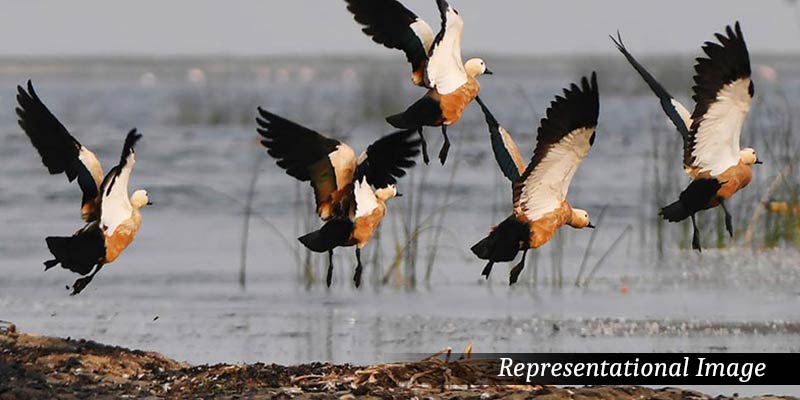- India
- Jan 06
97 bird species recorded at Assam’s only Ramsar Site
Over 26,000 birds of 97 species were recorded during an initiative in Deepor Beel in Guwahati, the only Ramsar Site in Assam.
There was a significant increase from 10,289 winged friends, belonging to 66 species, in the previous bird-counting exercise in 2021 to 26,647 this time.
Deepor Beel is a permanent freshwater lake in a former channel of the Brahmaputra river of great biological importance.
The beel is a staging site on migratory flyways and some of the largest concentrations of aquatic birds in Assam can be seen, especially in winter.
What is the Ramsar Convention?
• The Ramsar Convention is an international treaty signed by 172 countries to protect wetlands. It is named after the city in Iran where it was signed, and it began with 18 countries in 1971.
• The convention is one of the oldest inter-governmental accords for preserving the ecological character of wetlands. Also known as the Convention on Wetlands, it aims to develop a global network of wetlands for the conservation of biological diversity and for sustaining human life.
• It is one of the largest international agreements, after the Convention on Biological Diversity (CBD, 196 countries) and the UN climate agreement (UNFCCC, 197 countries).
• The Ramsar List is the world’s largest network of protected areas.
• There are over 2,400 Ramsar Sites around the world. The first Site was the Cobourg Peninsula in Australia, designated in 1974. The largest Sites are Rio Negro in Brazil (120,000 sq km), and Ngiri-Tumba-Maindombe in the Democratic Republic of Congo and Queen Maud Gulf in Canada. These Sites each cover over 60,000 sq km.
• The countries with the most Sites are the United Kingdom with 175 and Mexico with 142. Bolivia has the largest area with 148,000 square km under the Convention protection.
• In India, 75 wetlands covering an area of 1,326,677 hectares have been designated as Ramsar Sites of International Importance from India.
• The signatory countries promise to make inventories of their Ramsar Sites and to develop management plans. These management plans include the sustainable use of the many other functions of wetlands, such as food production, water storage and recreation.
What are wetlands?
• Wetlands are land areas that are saturated or flooded with water either permanently or seasonally. Inland wetlands include marshes, ponds, lakes, fens, rivers, floodplains and swamps. Coastal wetlands include saltwater marshes, estuaries, mangroves, lagoons and even coral reefs. Fish ponds, rice paddies and saltpans are man-made wetlands.
• Wetlands, often known as ‘liquid assets’, are crucial natural resources that help stabilise water supplies, cleanse polluted waters and protect shorelines.
• Wetlands provide a wide range of important resources and ecosystem services such as food, water, fibre, groundwater recharge, water purification, flood moderation, erosion control and climate regulation.
• They are, in fact, a major source of water and our main supply of freshwater comes from an array of wetlands which help soak rainfall and recharge groundwater.
• Every year, February 2 is observed as World Wetlands Day to raise global awareness about the vital role of wetlands for our planet. This day also marks the date of the adoption of the Convention on Wetlands on February 2, 1971, in Ramsar, Iran.
Criteria for identifying Wetlands of International Importance
A wetland should be considered internationally important:
1) If it contains a representative, rare, or unique example of a natural or near-natural wetland type found within the appropriate biogeographic region.
2) If it supports vulnerable, endangered, or critically endangered species or threatened ecological communities.
3) If it supports populations of plant and/or animal species important for maintaining the biological diversity of a particular biogeographic region.
4) If it supports plant and/or animal species at a critical stage in their life cycles, or provides refuge during adverse conditions.
5) If it regularly supports 20,000 or more waterbirds.
6) If it regularly supports 1 per cent of the individuals in a population of one species or subspecies of waterbird.
7) If it supports a significant proportion of indigenous fish subspecies, species or families, life-history stages, species interactions and/or populations that are representative of wetland benefits and/or values and thereby contributes to global biological diversity.
8) If it is an important source of food for fishes, spawning ground, nursery and/or migration path on which fish stocks, either within the wetland or elsewhere, depend.
9) If it regularly supports 1 per cent of the individuals in a population of one species or subspecies of wetland-dependent non-avian animal species.
UPSC Civil Services Examination Previous Year Question (2022)
Consider the following pairs :
Wetland/Lake Location
1. Hokera Wetland - Punjab
2. Renuka Wetland - Himachal Pradesh
3. Rudrasagar Lake - Tripura
4. Sasthamkotta -. Tamil Nadu Lake
How many pairs given above are correctly matched ?
(a) Only one pair (b) Only two pairs (c) Only three pairs (d) All four pairs
Answer: b
“If rainforests and tropical forests are the lungs of the Earth, then surely wetlands function as its kidneys.” Which one of the following functions of wetlands best reflects the above statement?
(a) The water cycle in wetlands involves surface runoff, subsoil percolation and evaporation.
(b) Algae form the nutrient base upon which fish, crustaceans, molluscs, birds, reptiles and mammals thrive
(c) Wetlands play a vital role in maintaining sedimentation balance and soil stabilization.
(d) Aquatic plants absorb heavy metals and excess nutrients
Answer: d.

